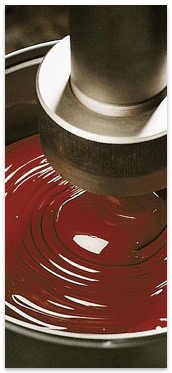
Dispersion Formulation
OVERVIEW
Agfa’s Colloidal Expertise
AGFA has an extensive expertise in the development and production of colloidal systems which is rooted into Agfa’s long history as a major producer of coated films and speciality chemicals.
Moreover, AGFA’s technologies are more relevant than ever for new product developments related to colloids or nanomaterials. In fact, a significant portion of Agfa’s historical processes is actually about nanotechnology before the word became well-spread.
By working together with Agfa you will not only benefit from our versatile equipment infrastructure, but also from our extensive expertise in the formulation of complex materials. Even if your application is not directly related to AGFA’s activities, we believe that we can help you as colloid chemistry is universal and many solutions are directly transposable to completely different products.
AGFA is constantly seeking new business opportunities in-line with the company’s competencies and infrastructure that can deliver added value to both parties. Depending on your project and needs, we can prepare and optimize formulations on small scale for feasibility studies, develop up-scaling processes and/or proceed to toll-in production.
Your Possibilities at Agfa
R&D laboratories, including up-scaling, and production facilities are available for the development of dispersions or emulsions (water- or solvent-based). The installations we use are in service for many years for manufacturing coating and ink formulations.
AGFA’s technologies and know-how can also be applied for the production of (nano)dispersed systems used in other areas such as cosmetics, pharmacy, agriculture, coatings, paints, inks, food, electronics, adhesives, cement.
TECHNIQUES
- The formulation of stable colloidal systems (having at least one specific dimension between < 100 nm and > 1 μm) is a key competence of AGFA.
- From laboratory developments to the possibility of toll-in manufacturing, our dedicated team of colloid scientists can assist you and your company at any stage of your project to achieve your goals. The breadth of our methods ensures that we will be able to answer most of your requests regarding emulsions and dispersions up to the nanosize range.
- Processes based on high-shear forces
- Mechanical stirring is the simplest way to produce emulsions or dispersions with a rotary dissolver or a rotor / stator mixer. The latter is particularly useful for emulsions. Depending on the system, batches from a few mL to more than 200 L can be produced.
- High-pressure homogenization is a powerful technique to produce emulsions or dispersions with a small droplet or particle size and narrow size distribution.
- Processes based on impact forces
- Ball mills are suitable to produce dispersions and break-up most aggregated powders into their primary constituents. Screening of formulation ingredients on scales comprised between 40 g and 100 g is possible.
- Agitated bead mills are most suited for high-end applications. They can deliver very fine solid dispersions with a small particle size in a suitable liquid medium.
- Physico-chemical processes
- In melt dispersions the product to be dispersed is brought above its melting point, emulsified and cooled down to room temperature where it solidifies to form a stable dispersion. It is very effective to produce dispersions free of volatile organic compounds (VOC’s).
- In precipitation dispersions the product to be dispersed is dissolved in the medium and precipitated with a suitable stimulus, e.g. by varying pH, to obtain the desired dispersion.
- In an emulsion-solvent evaporation process the product to be dispersed is dissolved in a good solvent and emulsified before stripping the solvent to give the (nano-)dispersion or emulsion. It is more versatile than the previous two methods and batches from 500 mL to more than 1000 L can be produced.
- Processes based on high-shear forces
- The choice of the most suitable dispersion process technology depends on the system and the application. AGFA’s dispersion processes are compatible with water, solvent and UV or thermally curable systems.
- Overview of the techniques/methods available at AGFA:(*) theoretically
Emulsion Dispersion Media Mechanical Stirring V V solvent water High-Pressure Homogenisation V V (*) solvent water Melt Dispersion X V solvent water Precipitation Dispersion X V solvent water Ball Milling X V solvent water Bead Milling X V solvent water Emulsion-Solvent Evaporation V V water solvent (*)
EQUIPMENT AND METHODS
- Screening
- Formulation Research
- Development Research
- Pilot Batch Production
- Introduction into production
- Ad-hoc problem solving
Let's Talk
Fill out this form, and we'll revert to you as soon as possible.
Please provide a detailed description of your question or request.
